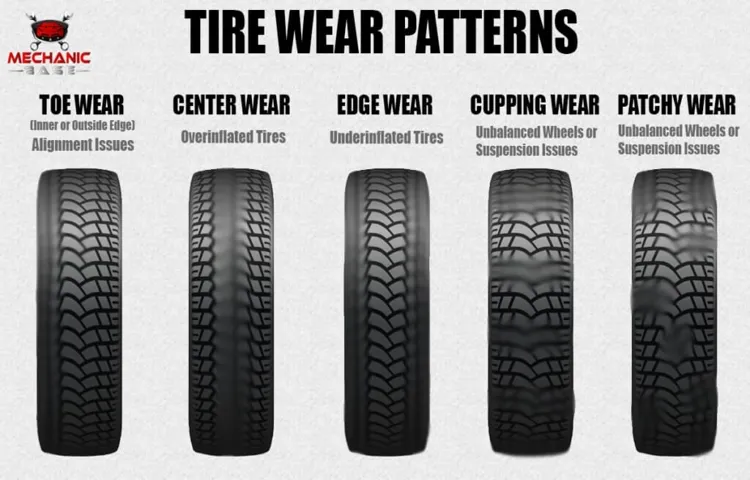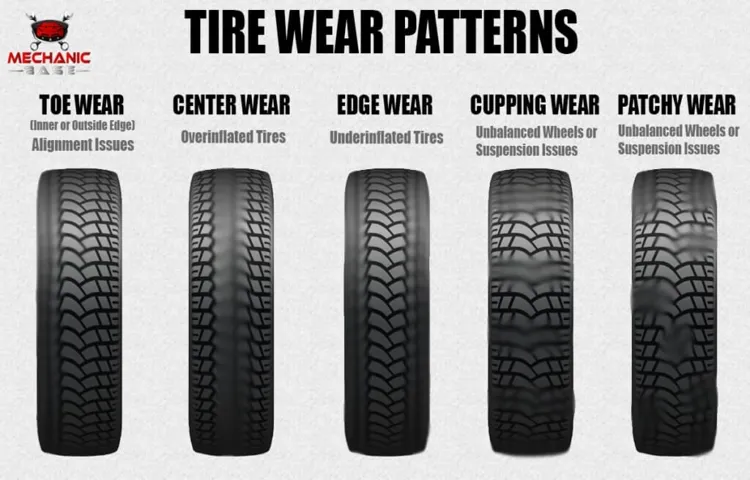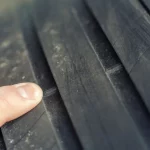Have you ever noticed that your car’s tires wear down unevenly? Did you know that this wear pattern can actually be quite useful? That’s right, the way your tires wear down can give you valuable information about your vehicle’s alignment and other issues. By paying attention to the wear pattern, you can spot problems early and prevent more serious issues down the line. In this blog post, we’ll take a closer look at tire wear patterns and why they are so important for maintaining the health of your car.
So buckle up and get ready to learn!
Table of Contents
Understanding the Importance of Tire Wear Patterns
When it comes to maintaining your vehicle, understanding tire wear patterns is crucial. Tire wear patterns can indicate whether your tire is properly inflated, if your vehicle is out of alignment, or if there is an underlying issue with your suspension system. It’s important to catch these issues early on to prevent further damage to your tire, and potentially your vehicle.
By regularly inspecting your tire wear patterns, you can catch issues before they become more expensive problems to fix. In addition, paying attention to tire wear patterns can also improve your overall driving experience by ensuring a smoother and safer ride. So, the next time you’re getting your vehicle serviced, make sure to ask your mechanic about your tire wear patterns and what they may be indicating.
Safety Benefits of Tire Wear Patterns
Understanding tire wear patterns is crucial for the safety of the vehicle and its occupants. Tire wear patterns are a result of the way a tire wears out over time due to its contact with the road surface. These patterns can indicate problems with the vehicle’s alignment, suspension, and tire pressure.
The most common tire wear patterns include cupping, feathering, and camber wear. Cupping occurs when the tire wears unevenly due to the suspension being worn out, resulting in the edges of the tread being higher than the center. Feathering is caused by improper alignment and results in the tread being worn on one side more than the other, resembling a feather.
Camber wear happens when the tire tilts inwards or outwards, causing the tire to wear unevenly on one side. By understanding and addressing these tire wear patterns, vehicle owners can ensure their tires last longer, improve the vehicle’s handling, and most importantly, increase safety on the road.

Performance Benefits of Tire Wear Patterns
When it comes to maintaining the performance of your vehicle, understanding the importance of tire wear patterns can be crucial. As your tires gradually wear down, patterns will start to form that can greatly impact your driving experience. For example, if your tires become misaligned or worn unevenly, it can cause your vehicle to pull to one side or create a bumpy ride.
Additionally, certain wear patterns can indicate issues with your suspension or alignment, which left unchecked, can cause larger issues down the road. By regularly checking your tires for wear patterns and addressing any issues as needed, you can ensure a smoother, safer, and more efficient drive. So, don’t neglect your tire care – it could make all the difference in the performance of your vehicle on the road.
Types of Tire Wear Patterns
Why is a tire wear pattern useful, you may ask? Well, it tells quite a lot about the state of your car’s tires. Depending on the type of wear pattern, drivers can diagnose underlying problems and take corrective action before the situation becomes dangerous. For example, if the tires have a wear pattern that is more prominent on one side than the other, it may be an indication of poor alignment.
Similarly, if the tread wears out much faster in the middle of the tire than the sides, the air pressure may be too high. By paying attention to the wear pattern of your tires, you can save money by replacing them less often and avoid potentially dangerous situations on the road. It’s essential to get your tires checked by a mechanic and rotate them regularly to ensure that wear is distributed evenly.
By doing this, you can get more miles out of your tires, improve fuel efficiency, and make your car safer to drive.
Identifying Common Tire Wear Patterns
When it comes to tire wear patterns, it’s essential to understand the different types of wear to maintain proper driveability, performance, and most importantly, safety. As tires age, they undergo various types of wear, including cupping, feathering, and bald spots. Cupping occurs when the tire tread wears unevenly and forms a pattern of high and low spots, resulting in a noisy ride and uneven tire wear.
Feathering occurs when the tread wears on one side of the tire and not the other, creating a saw-like pattern, causing a tire to hum and require premature replacement. Bald spots are the most commonly known tire wear pattern, resulting from over-inflation or under-inflation, causing the center or outer edges of the tire to wear faster than other areas. By understanding the different types of tire wear patterns, you can detect and address issues early, prolonging the tire’s longevity, maintaining optimal performance, and most importantly, ensuring your safety while on the road.
Causes and Potential Solutions for Tire Wear Patterns
When it comes to tires, wear patterns are an inevitable occurrence. However, understanding the different types of tire wear patterns can help identify underlying issues and potentially prevent further damage. One common type of tire wear pattern is called cupping, which looks like small dips or hills on the surface of the tire.
This type of wear occurs when the tire bounces up and down on the road, often caused by worn shocks or suspension parts. Feathering is another type of wear pattern, which appears as diagonal strips running along the length of the tire. This occurs when the tire is misaligned or when one edge of the tread blocks is wearing down faster than the other.
Other types of wear patterns include center wear, shoulder wear, and uneven wear across the tread. To prevent excessive tire wear, it is recommended to regularly inspect the tires for signs of wear and tear, maintain proper tire pressure, and seek professional help if any concerning patterns arise.
Tire Wear Patterns and Vehicle Maintenance
Tire Wear Patterns When it comes to maintaining your vehicle, one important aspect to keep in mind is tire wear patterns. This can give you an idea of the condition of your tires and help prevent potential problems in the future. One type of wear pattern is known as center wear, which occurs when the middle part of the tire wears down faster than the outer edges.
This is often a sign that the tire pressure is too high. On the other hand, if the outer edges are wearing more quickly, this is known as shoulder wear and can indicate that your tires are underinflated. Another type of wear pattern is called cupping, which shows up as irregular dips or scallops on the tire’s surface.
This can be caused by a suspension or alignment issue and should be addressed immediately. It’s always important to pay attention to tire wear patterns as they can help identify potential issues with your vehicle, ultimately ensuring that you stay safe on the road.
Conclusion
In summary, understanding tire wear patterns is crucial as they can provide valuable information about the overall health and performance of your vehicle. By studying these patterns, you can identify potential issues early on, such as misaligned wheels or incorrect tire pressure, and take corrective action before they lead to costly repairs or safety concerns. So, the next time you notice some unusual tire wear, don’t disregard it – it could be your vehicle’s way of telling you something important! Remember, proper tire maintenance is not just about saving money, but also about ensuring your safety on the road.
Happy driving!”
FAQs
1. What are the different types of tire wear patterns? A: The common types of wear patterns include center wear, edge wear, cupping wear, diagonal wear, and flat-spot wear. 2. How can tire wear patterns indicate alignment problems? A: If the tire wears irregularly either on the inside or outside edges, it’s a sign that the wheels are misaligned, which can lead to uneven tire wear. 3. Why is it important to rotate tires regularly? A: Regular tire rotation helps to ensure even wear on all tires, which extends their lifespan and maintains their performance. 4. Is tire wear pattern affected by driving habits? A: Yes, aggressive braking, accelerating, or turning can cause uneven wear patterns on the tires, leading to premature wear and tear. 5. How often should I check my tire wear patterns? A: It’s recommended to check the tire wear patterns every few months, especially after long trips, to ensure that the tires are in good condition. 6. Can incorrect tire pressure affect wear pattern? A: Yes, if the tire pressure is too low or too high, it can cause uneven wear patterns on the tire, and may even lead to tire blowouts. 7. How can I prevent tire wear patterns? A: Tire wear patterns can be prevented by maintaining proper inflation levels, getting regular tire rotations, and avoiding aggressive driving habits.



